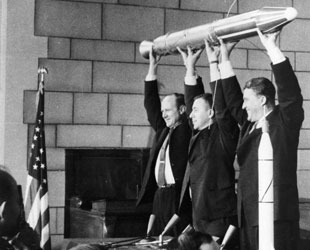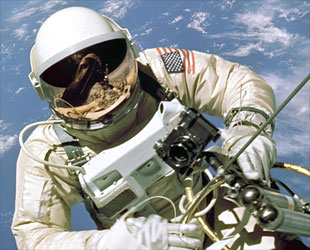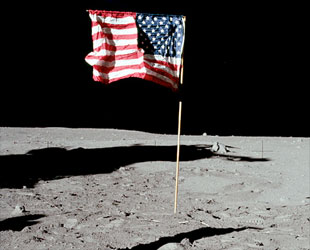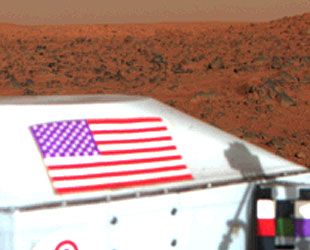July 4, 2010 — Fifty years ago Sunday, on Independence Day 1960, the United States officially adopted use of the 50-star American flag, increasing the star-count by one to recognize Hawaii's statehood. This, the 27th update to the star-spangled banner, became the U.S. flag to be longest used and the only one to represent the nation in space.
Despite having launched satellites for two-and-a-half years prior to the 50-star flag being unfurled, the country's first flag did not enter space until nearly a year after the banner was introduced.
The first U.S. satellite, Explorer 1, was launched on Jan. 31, 1958 without the stars and stripes adorning its or its Juno 1 rocket's body. Once it was confirmed Explorer was in orbit, its designers announced their success at a press conference, lifting a replica of the man-made moon above their heads.
A now-famous photo captured William Pickering, James Van Allen, and Wernher von Braun hoisting the full-size Explorer 1 model adjacent to a 48-star American flag.

William Pickering, James Van Allen, and Wernher von Braun hold up an Explorer 1 model near a 48-star U.S. flag. (NASA) |
The first U.S. probe to enter space after July 4, 1960, was Echo 1A, a mylar inflatable 'satelloon' that was launched on August 12, 1960. Its ride to orbit, the first successful Delta rocket to fly, was decorated like other boosters of its day. The rocket had "UNITED STATES" stenciled on its side, but no flag.
The first 50-star flag to fly in space — indeed, the first American flag to have ever left the planet — did so in May 1961, alongside another U.S. first: Alan Shepard, the first U.S. astronaut in space.
Correction (Aug. 20, 2020): The first American flag to fly into space and be returned intact to Earth was aboard the Discoverer XIII reentry capsule in August 1960.
Students' stow-away stars and stripes
The first American flag to ride the "rocket's red glare" did not originate with the President or Congress, or even from NASA officials. The man who would fly on the suborbital mission with the banner, Alan Shepard, was even unaware that it was onboard.
The 23- by 36-inch cloth flag came instead from a school located near Cape Canaveral, Florida, where the flag and Shepard would launch aboard Mercury-Redstone 3 on the spacecraft "Freedom 7."
"The student council president and the principal of Cocoa Beach School near the Florida launch site gave the flag to a reporter, who in turn gave it to the head of the NASA Space Task Group, Robert Gilruth, with the request that it be included on Mercury-Redstone 3 (MR-3), if possible," according to a description on the Smithsonian's website. "The flag was rolled up and stuck in a wiring bundle in Shepard's spacecraft, Freedom 7, although he was not aware that it was there."
"After the mission, Gilruth returned the flag to the school, which was later called the Freedom 7 School."
In 1984, after the school closed, the flag was donated by the Brevard County Board of Education to the National Air and Space Museum.

A 50-star American flag displayed with the Russian flag aboard the Russian Mir station during the STS-71 mission. (NASA) |
But Mercury 3 was not the only flight for the first U.S. flag in space. It reached orbit onboard the 100th U.S. manned flight, STS-71, which also marked the first docking of a U.S. space shuttle to Russia's Mir space station.
After returning from space in 1995 for a second time, the flag was presented by Shepard and STS-71 commander Robert "Hoot" Gibson" for display at the Astronaut Hall of Fame in Titusville, Florida, where it remains today.
Flying the flag
Old Glory's flight on Mercury-Redstone 3 began a tradition of flying American flags on every U.S. manned (and many unmanned) missions.
The red, white and blue banner also began appearing on the outside of U.S. spacecraft. When John Glenn became the first American in orbit in 1962, his Mercury spacecraft included the 50-star and 13-stripe flag on its exterior, as did the capsules that followed it.
The first astronauts to add the flag to their spacesuits flew aboard Gemini IV in 1965.

Astronaut Ed White, performing the first U.S. spacewalk, was among the first to wear the American flag in space. (NASA) |
"Ed White and I used the American flag on our shoulders as our patch. This was the first time the American flag had been worn on a pressure suit and it has continued to be used there ever since. The original flags we had sewn on we purchased ourselves. Later on, of course, NASA made this an integral part of the pressure suit," recounted James McDivitt, Gemini IV commander, in the book "All We Did Was Fly to the Moon."
White, who on that same flight became the first American to spacewalk, described his experience floating free of the spacecraft as having felt "red, white and blue all over."
Perhaps the most famous 50-star flag ever flown — on or off Earth — was the 3- by 5-foot flag planted on the moon by Neil Armstrong and Buzz Aldrin on July 20, 1969. More than 500 million watched the flag being deployed, though the action was not done without some difficulty.
"We had some difficulty, at first, getting the pole of the flag to remain in the surface," reported Armstrong during a post-flight briefing. "In penetrating the surface, we found that most objects would go down about five, maybe six, inches and then it would meet with a gradual resistance. At the same time, there was not much of a support force on either side, so we had to lean the flag back slightly in order for it to maintain this position."

The American flag planted at Tranquility Base on the moon by Neil Armstrong and Buzz Aldrin on July 20, 1969. (NASA) |
Five more American flags followed that one at Tranquility Base to the moon, symbolizing the country's success in space. Subjected to solar radiation for four decades, it is believed that by today the flags' red and blue would be all but faded to white and the nylon itself will have fallen apart.
Each of the Apollo missions, like the shuttle missions that continue to present day, had onboard hundreds of smaller 4- by 6-inch nylon U.S. flags that were distributed after their return to Earth to dignitaries and NASA employees.
Notably, 6,000 of the small U.S. flags were carried on the STS-108 mission in December 2001, as part of the Flags for Heroes and Families campaign to honor the victims of the September 11 terrorist attacks on the United States.
Additional flags have traveled into — and even out of — the solar system with the nation's unmanned probes. The first U.S. flag on Mars landed with Viking I in 1976. Originally intended to touchdown on July 4 on the U.S. bicentennial and 16th anniversary of the 50-star flag, the lander with its stars and stripes reached the surface on July 20.

Viking 1's American flag the surface of Mars in 1976. (NASA) |
Depending on the chosen definition, American flags have now visited all the planets in the solar system and one is now on its way to Pluto aboard the fastest spacecraft ever launched from Earth, New Horizons.
The farthest-out 50-star American flag is packed onboard Voyager 1, currently traveling 10.5 billion miles from Earth at the outskirts of the solar system. A similar 16-inch long flag is onboard Voyager 2, which is about 8.6 billion miles out.
